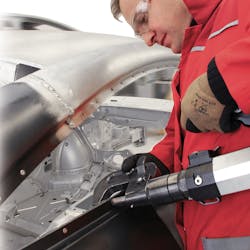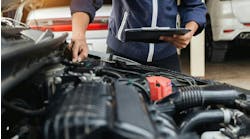In the complex world of modern automotive repair, even the smallest components play a pivotal role in ensuring the structural integrity and safety of vehicles. OEM rivets, seemingly inconspicuous, are a prime example. The process of testing these rivets is a critical aspect of collision repair, ensuring that repaired vehicles adhere to the highest safety standards. OEM equipment is often imitated but never equaled. This article delves into the significance of testing OEM rivets and presents an in-depth analysis of a recent rivet test – IP-161: Testing 8mm Flow-Form Rivets.
Unveiling the contents of rivet testing
List of specimens (materials combinations)
The foundation of any rivet test lies in the diverse combinations of materials that are used. These combinations reflect real-world scenarios, as different vehicles may have varying materials and thicknesses. This test included specimens crafted from DP980, HS350, Aluminum 6111 (both 2.0 mm and 3.0 mm thicknesses).
Results - tensile shear test and cross tension test (AWS D8.1M)
The rivet-testing process encompasses two critical evaluations: the Tensile Shear (TS) Test and the Cross Tension (CT) Test. These evaluations adhere to the American Welding Society (AWS) D8.1M standard, ensuring the highest level of accuracy and consistency.
Series A: DP980 (t=1.5 mm) showcased an average tensile shear strength of 12.38 kN and cross tension strength of 5.41 kN.
Series B: HS350 (t=2.5 mm) exhibited an average tensile shear strength of 15.67 kN and cross tension strength of 8.49 kN.
Series C: Aluminum 6111 (t=2.0 mm) displayed an average tensile shear strength of 8.99 kN and cross tension strength of 4.55 kN.
Series D: Aluminum 6111 (t=3.0 mm) demonstrated an average tensile shear strength of 12.73 kN and cross tension strength of 8.30 kN.
Understanding AWS definitions
Embedded within the rivet testing process are AWS definitions that provide the parameters and standards against which the rivets are evaluated. These definitions, established by the American Welding Society, ensure consistency and clarity in the testing process, leaving no room for ambiguity.
Deciphering the implications of test results
The rivet testing culminated in a comprehensive analysis of the results. Each series of rivets underwent Tensile Shear and Cross Tension tests, and the averages and standard deviations were calculated. This meticulous process ensures that the strength of the rivets is well-documented, enabling collision repair professionals to make informed decisions.
The overarching importance of rivet testing
The intricate process of testing OEM rivets serves as a cornerstone in the collision repair industry. The results of such tests guide repair professionals in selecting the appropriate rivets for a specific repair scenario, ensuring that structural integrity and safety are maintained post-repair. The data gleaned from these tests empowers professionals to make precise decisions, contributing to the overall safety and longevity of repaired vehicles.
Conclusion: Upholding safety through rigorous testing
In the realm of automotive repair, precision and safety are paramount. The testing of OEM rivets, such as the detailed IP-161 test, stands as a testament to the commitment of professionals in upholding these standards. As the automotive landscape continues to evolve, the meticulous testing of components like rivets becomes even more critical. At RAE, we only recognize OEM-certified parts and the pivotal role that testing plays in ensuring the safety and reliability of repaired vehicles. To discover more about our dedication to automotive safety and excellence, visit our website at raeservice.com.



